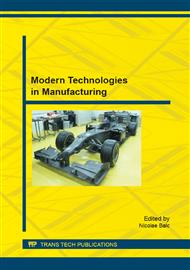[1]
C.Ş. Borzan, P. Berce, H. Chezan, E. Sabău, S.A. Radu and M. Ridzon: Physico-Mechanical Properties Characterization of the Parts from PA 2200 Manufactured by Selective Laser Sintering Technology. Academic Journal of Manufacturing Engineering. Vol. 11, Issue 4/2013, pp.108-113.
Google Scholar
[2]
R. Pacurar, N. Balc and F. Prem: Research on how to improve the accuracy of the SLM metallic parts. 14th International Conference on Material Forming ESAFORM, 2011, Proceeding, Vol. 1353, pp.1385-1390, (2011).
DOI: 10.1063/1.3589710
Google Scholar
[3]
R. Pacurar, A. Pacurar: Finite Element Analysis to improve the accuracy of parts made by stainless steel 316L material using Selective Laser Melting Technology. Applied Mechanics and Materials. Vol. 657, pp.236-240, (2014).
DOI: 10.4028/www.scientific.net/amm.657.236
Google Scholar
[4]
A. Luca, N. Balc, I. Drstvensek and A. Popan: Analysis of aluminium parts for accuracy improvement in vacuum casting process. Academic Journal of Manufacturing Engineering. Vol. 9, Issue 3/2011. Editura Politehnica. pp.74-79, (2011).
Google Scholar
[5]
A. Popan, N. Balc, A. Carean, A. Luca and A. Miron: Research on Abrasive Water Jet Milling of the Planar Surfaces, Slots and Profiles. Applied Mechanics and Materials. Vol. 760 (2015) pp.409-414.
DOI: 10.4028/www.scientific.net/amm.760.409
Google Scholar
[6]
V.A. Ceclan, N. Balc, S. Grozav, P. Bere and C.S. Borzan: Quality of the hydroformed tubular parts. Advanced Engineering Forum. Vols. 8-9, pp.215-224, (2013).
DOI: 10.4028/www.scientific.net/aef.8-9.215
Google Scholar
[7]
P. Bere, P. Berce and O. Nemeş: Phenomenological fracture model for biaxial fibre reinforced composite. Composites Part B: Engineering. An International Journal Vol. 43 (2012) 2237–2243.
DOI: 10.1016/j.compositesb.2012.01.073
Google Scholar
[8]
H. Iancau, P. Bere, M. Borzan, L. Hancu and A. Crai: The influence of reinforced materials and manufacturing procedures on the mechanical characteristics of polymeric composite materials. J Mater Plast. Vol. 45, nr. 3, pp.251-256, (2008).
Google Scholar
[9]
T. Várady, R.R. Martin, J. Cox: Reverse engineering of geometric models – an introduction. Computer-Aided Design, 29(4), pp.255-268. (1997).
DOI: 10.1016/s0010-4485(96)00054-1
Google Scholar
[10]
L. Morovič, P. Pokorný: Optical 3D Scanning of Small Parts. Advanced Materials Research, Vols. 468-471, pp.2269-2273, (2012).
DOI: 10.4028/www.scientific.net/amr.468-471.2269
Google Scholar
[11]
M. Očenáš: Audiovizuálna podpora pre tvorbu CAD modelov z polygónovej siete (Audiovisual support for creating CAD models from polygonal mesh). [Master Thesis] - Slovak University of Technology Bratislava. Faculty of Materials Science and Technology; Institute of Production Technologies. Trnava: MTF STU, 2015. 96 p.
DOI: 10.17973/mmsj.2021_12_2021128
Google Scholar
[12]
K. Chang, C. Chen: A Review on Shape Engineering and Design Parameterization in Reverse Engineering. In: Computer-Aided Design & Applications, 8(5), pp.681-692, (2012).
DOI: 10.3722/cadaps.2011.681-692
Google Scholar


